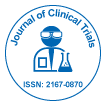
Journal of Clinical Trials
Open Access
ISSN: 2167-0870

ISSN: 2167-0870
Perspective - (2025)Volume 15, Issue 6
Rare diseases, often defined as conditions affecting a small proportion of the population, pose unique challenges for clinical research and drug development. Despite their individual rarity, collectively these diseases affect millions of people worldwide, many of whom face limited treatment options. Clinical trials in rare diseases are essential for evaluating new therapies, but they require innovative approaches to overcome obstacles such as small patient populations, heterogeneous disease manifestations and limited scientific understanding.
The design of clinical trials for rare diseases differs from those for common conditions. Traditional randomized controlled trials may be impractical due to difficulties in recruiting sufficient participants. As a result, alternative methodologies are often employed. Single-arm trials, where all participants receive the investigational treatment, are frequently used when withholding therapy would be unethical. Historical controls or natural history studies may provide comparative data in the absence of a control group. Adaptive trial designs, which allow for modifications based on interim results, are particularly valuable in maximizing data from small cohorts.
Patient recruitment is one of the most significant challenges in rare disease trials. Patients may be geographically dispersed, making it difficult to gather enough participants at a single site. To address this, global collaborations and multi-center trials are increasingly common. By pooling resources and expertise across countries, researchers can access broader patient populations and generate more generalizable results. Patient advocacy groups also play a vital role in recruitment by connecting researchers with affected individuals and raising awareness about trial opportunities.
Another complexity in rare disease trials is disease heterogeneity. Many rare conditions present with diverse symptoms and progression rates, complicating the identification of standardized outcome measures. To address this, researchers often rely on surrogate endpoints, such as biomarker changes, which may provide earlier indications of therapeutic benefit. Regulatory agencies, including the U.S. Food and Drug Administration (FDA) and the European Medicines Agency (EMA), have shown flexibility in accepting surrogate endpoints in rare disease trials, recognizing the urgent need for treatments.
Ethical considerations are heightened in rare disease research. Informed consent must account for the limited information available about the condition and the experimental nature of treatments. Families, particularly when children are involved, face difficult decisions about trial participation. Ensuring transparency, providing accessible information and involving patient communities in trial design help to build trust and promote ethical conduct.
Technological advancements are transforming the landscape of rare disease trials. Genomic sequencing has enabled more precise diagnosis and classification of rare conditions, guiding the development of targeted therapies. Digital health tools, including wearable devices and remote monitoring, reduce the burden on patients by allowing data collection outside of clinical sites. These technologies not only improve trial accessibility but also enhance data quality by capturing real-world patient experiences.
Regulatory frameworks support innovation in rare disease research through incentives such as orphan drug designation. These programs provide benefits such as tax credits, extended market exclusivity and fee reductions, encouraging pharmaceutical companies to invest in areas that might otherwise be financially unviable. The result has been a notable increase in the number of therapies developed for rare conditions, bringing hope to previously underserved patient communities.
Collaboration between stakeholders is essential for progress in rare disease trials. Partnerships among academia, industry, regulatory agencies and patient organizations facilitate knowledge sharing and accelerate the development of therapies. Patient input is particularly valuable in defining trial endpoints that reflect meaningful improvements in quality of life. This collaborative approach ensures that research addresses both scientific goals and patient needs.
Despite progress, rare disease trials continue to face limitations. Small sample sizes reduce statistical power, making it difficult to draw definitive conclusions. The reliance on surrogate endpoints raises questions about long-term clinical relevance. High costs and logistical challenges further complicate trial execution. Addressing these issues requires ongoing innovation in trial design, greater global coordination and continued regulatory flexibility.
Clinical trials in rare diseases are essential for translating scientific discoveries into practical treatments for patients with limited options. While challenges such as small populations and disease heterogeneity exist, innovative methodologies, global collaborations and patient-centered approaches are helping to overcome these barriers. Advances in genomics, digital technologies and supportive regulatory frameworks are further shaping the future of rare disease research. By uniting stakeholders and focusing on meaningful patient outcomes, clinical trials are paving the way toward improved care and new therapies for rare conditions worldwide.
Citation: Sam R (2025). Clinical Trials in Rare Diseases: Addressing Challenges and Advancing Therapies. J Clin Trials. 15:605.
Received: 01-Aug-2025, Manuscript No. JCTR-25-38684; Editor assigned: 04-Aug-2025, Pre QC No. JCTR-25-38684 (PQ); Reviewed: 19-Aug-2025, QC No. JCTR-25-38684; Revised: 28-Aug-2025, Manuscript No. JCTR-25-38684 (R); Published: 05-Sep-2025 , DOI: 10.35248/2167-0870.25.15.605
Copyright: © 2025 Sam R. This is an open-access article distributed under the terms of the Creative Commons Attribution License, which permits unrestricted use, distribution and reproduction in any medium, provided the original author and source are credited.